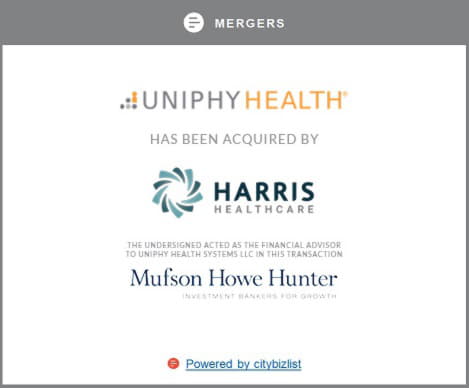MILLERSBURG, Pa., Oct. 29, 2020 (GLOBE NEWSWIRE) -- Mid Penn Bancorp, Inc. (NASDAQ: MPB), the parent company of Mid Penn Bank, today reported net income to common shareholders for the quarter ended September 30, 2020 of $6,547,000 or $0.78 per common share basic and diluted, compared to earnings of $4,813,000 or $0.57 per common share basic and diluted for the quarter ended September 30, 2019. Earnings for the nine months ended September 30, 2020 were $17,198,000 or $2.04 per common share basic and diluted, compared to earnings of $13,293,000 or $1.57 per common share basic and diluted for the nine months ended September 30, 2019. The year-to-date earnings per share through September 30, 2020 reflect an increase of 29 percent compared to the earnings per share for the same period in the prior year.
With these third quarter results, on October 28, 2020, the Board of Directors of Mid Penn Bancorp, Inc. declared a quarterly dividend of $0.18 per common share, payable on November 23, 2020, to shareholders of record as of November 10, 2020.
Tangible book value per common share, a non-GAAP measure that is regularly reported in the banking industry and the most directly comparable non-GAAP measure to book value per share, was $21.46 as of September 30, 2020, reflecting a year-to-date increase of over 7 percent compared to the tangible book value per common share of $19.96 as of December 31, 2019. The GAAP measure of book value per share increased to $29.49 as of September 30, 2020, compared to $28.05 as of December 31, 2019. Please refer to the section included herein under the heading “Reconciliation of Non-GAAP Measures (Unaudited)” for a discussion of our use of non-GAAP adjusted financial information, which includes tables reconciling GAAP and non-GAAP adjusted financial measures for the periods ended September 30, 2020, December 31, 2019, and certain other periods.
Mid Penn also reported total assets of $3,052,935,000 as of September 30, 2020, reflecting an increase of $821,760,000 or 37 percent compared to total assets of $2,231,175,000 as of December 31, 2019, and an increase of $804,036,000 or 36 percent compared to total assets of $2,248,899,000 as of September 30, 2019. Included in this increase is the significant volume of $613,924,000 of Paycheck Protection Program (“PPP”) loans outstanding, net of deferred fees, as of September 30, 2020. Mid Penn was a significant PPP lender under this program which was created when the Coronavirus Aid, Relief, and Economic Security (“CARES”) Act was signed into law on March 27, 2020, by President Trump. Total core banking loans (total loans excluding both the PPP portfolio and mortgage loans held for sale) increased to $1,907,903,000 as of September 30, 2020, representing an annualized core loan growth rate of over 10 percent since the end of 2019. The asset growth was funded by both (i) $544,004,000 of deposit growth, representing an annualized deposit growth rate of 38 percent, including a year-to-date increase of $224,882,000 in noninterest-bearing deposits; and (ii) a $246,138,000 net increase in borrowings, including $203,842,000 of funding obtained from the Federal Reserve through the Paycheck Protection Program Liquidity Facility (“PPPLF”). Under the PPPLF, the Federal Reserve supplies financing to the Bank at a rate of 35 basis points (0.35%) for a term and amount determined based on the principal amount of PPP loans fully and specifically pledged as collateral in support of the PPPLF borrowings. Draws of PPPLF funds must be repaid to the Federal Reserve immediately after the specific PPP loans collateralizing the related draws are repaid to the Bank.
PRESIDENT’S STATEMENT
With a 36 percent increase in third quarter income and a 29 percent increase in year to date income, we are proud to announce these results to our shareholders and the investment community. The success of the last six months, even in the midst of a global pandemic and economic shutdown, is reflective of a company we believe is built not only for performance but sustainability.
The organic growth on both sides of the balance sheet during this time has been impressive. Even net of PPP loans and deposits, we have recognized an annualized growth rate of 12% in assets while controlling operating expenses and lowering the cost of funding. Non-interest income sources, primarily mortgage banking and fiduciary services, are off to the best combined year in our history, contributing a meaningful level to the overall income of the company.
Most importantly, our asset quality numbers remain strong. While we have experienced slight upticks in delinquency and problem loan balances, we do not believe that those will have an impact on our net charge off ratio, which remains at zero percent through the first nine months of 2020.
With the success of the quarter, we are pleased to continue our cash dividend at $0.18 a share at a time when many financial institutions are either decreasing or eliminating their dividends. While the Board of Directors believes that, in an uncertain environment, capital preservation is of utmost importance, we also want to consistently reward our shareholders for their investment based upon the fruits of our labor. A 23 percent dividend payout ratio for the quarter allows us to achieve both objectives.
OPERATING RESULTS
Net Interest Income and Net Interest Margin
For the three months ended September 30, 2020, net interest income was $21,408,000, an increase of $3,641,000 or 20 percent compared to net interest income of $17,767,000 for the three months ended September 30, 2019. Through the first nine months of 2020, net interest income was $60,419,000, an increase of $7,576,000 or 14 percent compared to net interest income of $52,843,000 for the same period in 2019. The year-over-year increase for the nine-month period included $2,622,000 of net interest income from core loan and deposit growth, as well as the recognition of $4,954,000 of PPP loan processing fees generated as a result of Mid Penn’s participation in the PPP. These PPP fees are recognized in interest income over the term of the respective loan (most have a 24-month maturity), or sooner as the loans are forgiven by the Small Business Administration, or the borrowers otherwise pay down principal.
Mid Penn’s tax-equivalent net interest margin for the nine months ended September 30, 2020 was 3.29 percent versus 3.64 percent for the nine months ended September 30, 2019. For the quarter ended September 30, 2020, the net interest margin was 3.09 percent compared to 3.53 percent for the quarter ended September 30, 2019. Though the quarterly and year-to-date average balance of interest-earning assets increased year over year, the yields on interest earning assets declined due to both (i) the significant balance of PPP loans outstanding, which earn interest at a rate of 1 percent, and (ii) reductions in market interest rates subsequent to September 2019, including a rate decrease of 0.25 percent approved by the Federal Open Market Committee (“FOMC”) in October 2019, and 1.50 percent of combined FOMC rate cuts during March 2020 in response to the COVID-19 pandemic. Yields on loans and interest earning assets included the recognition of PPP loan processing fees in total interest income. The total cost of deposits for both the three and nine months ended September 30, 2020 favorably decreased compared to the same periods in 2019 as a result of the aforementioned growth in noninterest-bearing deposits and additional management deposit rate adjustments, including those made in response to the FOMC rate cuts, which collectively reduced deposit costs while still maintaining core deposit growth.
Noninterest Income
During the three months ended September 30, 2020, noninterest income totaled $5,302,000, an increase of $2,299,000 or 76 percent, compared to noninterest income of $3,003,000 for the three months ended September 30, 2019. For the nine months ended September 30, 2020, noninterest income totaled $11,858,000, an increase of $3,932,000 or 50 percent, compared to noninterest income of $7,926,000 for the same period 2019.
Mortgage banking income was $5,927,000 for the nine months ended September 30, 2020, an increase of $3,322,000 or more than double the mortgage banking income of $2,605,000 recorded during the nine months ended September 30, 2019. As longer-term mortgage interest rates have declined over the past twelve months, Mid Penn has significantly increased mortgage originations (both purchase and refinance activity) and secondary-market loan sales during 2020.
Income from fiduciary and wealth management activities was $1,267,000 for the nine months ended September 30, 2020, an increase of $175,000 or 16 percent, compared to fiduciary income of $1,092,000 for the same period in 2019. These additional revenues were attributed to growth in trust assets under management and increased sales of retail investment products, as well as additional fee income from Mid Penn’s expanded wealth management team.
ATM debit card interchange income was $1,426,000 for the nine months ended September 30, 2020, an increase of $278,000 or 24 percent compared to interchange income of $1,148,000 for the nine months ended September 30, 2019. The increase resulted from increasing card-based transaction usage across our expanding checking account customer base.
Net gains on sales of securities were $393,000 for the nine months ended September 30, 2020, an increase of $323,000 compared to net gains on sales of securities of $70,000 for the nine months ended September 30, 2019. These investment sales and gains reflect the continued implementation of asset/liability management strategies, which included effectively using some of these gains to offset $165,000 of debt prepayment penalties, recorded within other noninterest expenses, associated with the early redemption of higher-cost FHLB advances.
Service charges on deposits were $460,000 during the nine months ended September 30, 2020, reflecting a decrease of $205,000 or 31 percent when compared to the same period in 2019. The decrease is primarily due to less overdraft activity and, thus, less nonsufficient funds fees collected from deposit customers.
Net gains on sales of SBA loans were $435,000 for the nine months ended September 30, 2020, a decrease of $275,000 or 39 percent compared to net gains on sales of SBA loans of $710,000 during the same period of 2019. Much of the decrease is due to the temporary shift of the resources in our SBA lending function to focus on PPP loan processing, funding, and forgiveness, particularly during the second quarter of 2020.
Other income was $1,447,000 for the nine months ended September 30, 2020, an increase of $351,000 compared to other income of $1,096,000 for the nine months ended September 30, 2019. The increase in other income was primarily driven by higher volumes of fee-based income, including wire transfer fees, letter of credit fees, loan-level swap fees, and credit card program referrals and royalties.
Noninterest Expense
For the three months ended September 30, 2020, noninterest expense totaled $18,174,000, an increase of $3,491,000 or 24 percent, compared to noninterest expense of $14,683,000 for the three months ended September 30, 2019. For the nine months ended September 30, 2020, noninterest expense totaled $49,158,000, an increase of $5,376,000 or 12 percent, compared to noninterest expense of $43,782,000 for the nine months ended September 30, 2019. The year-over-year increase in quarterly noninterest expense was attributable to: (i) increased mortgage banking commissions expense, a component of personnel expenses, commensurate with the significant increase in mortgage loan originations and revenues; (ii) growth-related business development officer additions since September 30, 2019, including those in Mid Penn’s expanded wealth management and insurance service subsidiaries, and (iii) increases across other expense categories reflective of the overall growth of the organization, including FDIC assessment expense, software licensing and utilization, Pennsylvania bank shares tax, and occupancy and equipment expenses.
Salaries and employee benefits were $26,546,000 for the nine months ended September 30, 2020, an increase of $2,576,000 or 11 percent, versus the same period in 2019, with the increase primarily attributable to (i) increased commissions commensurate with the mortgage loan origination and sales success of the mortgage banking group, (ii) increased compensation expense for the substantial time and effort devoted to the PPP loan initiative by many of our staff members during 2020, and (iii) the addition of private banking and insurance business development professionals to enhance our wealth management and insurance services.
Pennsylvania bank shares tax expense was $869,000 for the nine months ended September 30, 2020, an increase of $129,000 or 17 percent compared to $740,000 for the nine months ended September 30, 2019. The increase in shares tax expense generally reflects the organic growth in the past year of the total shareholder equity balance upon which the tax is based, with some of the increase offset by state tax-credit-generating donations made during the first nine months of 2020.
FDIC assessment expense was $1,216,000 for the nine months ended September 30, 2020, an increase of $674,000 or 124 percent compared to $542,000 for the nine months ended September 30, 2019. The third quarter of 2019 reflected the receipt of $492,000 of FDIC small bank assessment credits, which were applied to FDIC assessment expense. Similar credits were not received in 2020. Additionally, total assessment expense for 2020 has increased when comparing to the same period in 2019, primarily due to the significant year-over-year increase in total average assets of the Bank on which the assessment is based.
Software licensing and utilization costs were $3,881,000 for the nine months ended September 30, 2020, an increase of $599,000 or 18 percent compared to $3,282,000 for the nine months ended September 30, 2019. This increase reflects the additional costs from both transaction volume-based charges, and licensing fees related to the addition of new staff and locations added since September 30, 2019, as well as costs associated with ensuring remote connectivity for an increased volume of employees in response to the COVID-19 work-from-home restrictions. Additionally, Mid Penn continued to invest in upgrades to internal systems, networks, storage capabilities, and data security mechanisms to enhance data management and security capabilities responsive to both the larger company profile and increasing complexity of information technology management.
Other expenses were $7,582,000 for the nine months ended September 30, 2020, an increase of $1,635,000 or 27 percent compared to $5,947,000 for the same period during 2019. This variance was largely driven by increases in several components of other expense, including (i) an increase in tax-credit-generating charitable donations expense, (ii) amortization of Mid Penn’s investment in a low- income housing partnership which began during the fourth quarter of 2019, (iii) revenue-sharing payments made for certain mortgage banking activities, and (iv) increases across several other categories of other expense reflecting growth within the organization, including stationary and supplies, printing, postage, and employee relations costs.
Legal and professional fees for the nine months ended September 30, 2020 decreased by $167,000 or 14 percent compared to the same period in 2019, due primarily to the first nine months of 2019 including additional services supporting a new third-party loan review service, as well as costs associated with supporting both trust and wealth management activities, and the update and revision of Mid Penn’s corporate governance and Board structure.
Marketing and advertising expense was $406,000 for the nine months ended September 30, 2020, a decrease of $237,000 or 37 percent compared to $643,000 during the first nine months of 2019. The first nine months of 2019 reflected additional advertising expense and promotional items expense to increase regional recognition and knowledge of Mid Penn’s First Priority Bank and expanded mortgage origination operations in Southeastern Pennsylvania. Similar expenses were not recognized in 2020. Additionally, as a result of the pandemic, in-person promotional events have been significantly reduced, resulting in less advertising and promotional items expense.
Intangible amortization decreased from $1,078,000 during the nine months ended September 30, 2019 to $966,000 during the nine months ended September 30, 2020, as the core deposit intangible (“CDI”) amortization from the 2018 acquisitions of both (i) the Scottdale Bank and Trust (“Scottdale”) on January 8, 2018, and (ii) First Priority Bancorp (“First Priority”) on July 31, 2018 continues to decrease as the CDI is amortized using the sum-of-the-years digits method over a ten year term (which results in decreasing expense recognized in each year following the respective acquisition).
The provision for income taxes was $3,221,000 during the nine months ended September 30, 2020, an increase of $682,000 or 27 percent compared to $2,539,000 for the same period in 2019. The provision for income taxes for the nine months ended September 30, 2020 reflects an effective Federal tax rate of 15.8%, compared to an effective Federal tax rate of 16.0% for the nine months ended September 30, 2019. The full-year tax provision through September 30, 2020 includes the impact of certain CARES Act provisions allowing for the carryback of federal tax net operating losses (NOLs) to prior periods in which the Federal tax rate was 34 percent. Mid Penn will carryback the NOLs acquired from First Priority and Scottdale, resulting in a $318,000 tax benefit due to carrying the NOLs back to 2017 when the federal statutory tax rate was higher (34 percent versus 21 percent).
FINANCIAL CONDITION
Loans
Total loans at September 30, 2020 were $2,521,827,000 compared to $1,762,756,000 at December 31, 2019, an increase of $759,071,000 or 43 percent since year-end 2019. Much of the growth is attributable to the funding of PPP loans during the second and third quarters of 2020, with $613,924,000 of PPP loans outstanding, net of deferred PPP processing fees of $15,929,000 as of September 30, 2020. The remaining increase of $145,147,000 (annualized growth rate of over 10 percent) was driven by organic growth, particularly within both commercial real estate credits, and commercial and industrial financing loans.
Investments
Mid Penn’s portfolio of held-to-maturity securities, recorded at amortized cost, increased $3,997,000 to $140,474,000 as of September 30, 2020, as compared to $136,477,000 as of December 31, 2019. Mid Penn’s total available-for-sale securities portfolio decreased $28,672,000 or 77 percent, from $37,009,000 at December 31, 2019 to $8,337,000 at September 30, 2020. The first nine months of 2020 reflected a higher volume of calls of both available-for-sale and held-to-maturity securities as market rates dropped due to both changes in the yield curve and from the FOMC reducing rates in response to the COVID-19 pandemic, leading to security issuers to execute calls on some higher coupon securities. Additionally, Mid Penn initiated some sales of available-for-sale investment securities for both portfolio and asset liability management.
Deposits
Total deposits increased $544,004,000 or over 28 percent, from $1,912,394,000 at December 31, 2019, to $2,456,398,000 at September 30, 2020 (annualized growth rate of 38 percent). Deposit growth was led by substantial increases in noninterest-bearing balances and money market deposits, primarily due to both new and expanded cash management and commercial deposit account relationships, including those from new customer relationships and deposits established as a result of Mid Penn’s PPP loan activities.
Short-Term Borrowings
Short-term borrowings of $203,842,000 at September 30, 2020 consisted entirely of Mid Penn’s utilization of the Federal Reserve’s PPPLF. The PPPLF allows banks to pledge PPP loans as collateral to borrow funds for up to a term of two years (to match the term of the respective PPP loans) at an interest rate of 0.35 percent. Mid Penn had no short-term borrowings as of December 31, 2019.
Long-Term Debt
Long-term debt increased from $32,903,000 at December 31, 2019 to $75,199,000 at September 30, 2020. During the second quarter of 2020, Mid Penn executed new Federal Home Loan Bank (“FHLB”) two-year term borrowings of $70,000,000 to fund anticipated core loan growth. This increase was partially offset by the prepayment of $27,500,000 of higher-cost long-term FHLB borrowings. Mid Penn recognized $165,000 of FHLB prepayment penalties, which were recorded within other noninterest expenses on the Consolidated Statements of Income. No FHLB borrowing prepayments occurred during the first nine months of 2019.
Subordinated Debt
Subordinated debt increased $14,902,000 or 55 percent, from $27,070,000 at December 31, 2019 to $41,972,000 at September 30, 2020. As previously reported on a Form 8-K dated March 20, 2020, Mid Penn entered into agreements for an aggregate of $15,000,000 of Subordinated Debt Notes due 2030 (the “Notes”) to accredited investors. The Notes bear interest at a rate of 4 percent per year for the first five years and then float at the Wall Street Journal’s Prime Rate, and are intended to be treated as Tier 2 capital for regulatory capital purposes.
Capital
Shareholders’ equity increased by $10,315,000 or 4 percent from $237,874,000 as of December 31, 2019 to $248,189,000 as of September 30, 2020. The increase in shareholders’ equity primarily reflects the growth in retained earnings through year-to-date net income, net of dividends paid. Some of the increase was offset by the initiation of Mid Penn’s treasury stock repurchase program, which reflected total common stock buybacks of $1,793,000 as of September 30, 2020. Regulatory capital ratios for both Mid Penn and its banking subsidiary exceeded regulatory “well-capitalized” levels at both September 30, 2020 and December 31, 2019.
ASSET QUALITY
The allowance for loan and lease losses as a percentage of total loans was 0.48% at September 30, 2020 compared to 0.54% at December 31, 2019 and September 30, 2019. Excluding PPP loans, which are guaranteed by the SBA and have no associated allowance, the allowance for loan and lease losses as a percentage of core loans was 0.64% as of September 30, 2020. Loan loss reserves as a percentage of nonperforming loans were 91% at September 30, 2020, compared to 79% at December 31, 2019, and 172% at September 30, 2019. Mid Penn had net loan charge-offs of $45,000 and $236,000 for the nine months ended September 30, 2020 and 2019, respectively.
The provision for loan losses was $2,700,000 for the first nine months of 2020, an increase of over 133 percent compared to a provision for loan losses of $1,155,000 for the first nine months of 2019. The allowance for loan losses and the related provision reflect Mid Penn’s continued application of the incurred loss method for estimating credit losses as Mid Penn is not yet required to adopt the current expected credit loss (“CECL”) accounting standard. The increase in the loan loss reserves and the provision was primarily the result of (i) providing for the year-to-date non-PPP loan growth, which was over 10 percent on an annualized basis, and (ii) an increase in qualitative factors related to economic and external conditions when compared to prior periods, with such changes driven by the potential for ongoing financial implications from the COVID-19 pandemic on Mid Penn’s customers and market area.
Total nonperforming assets were $15,082,000 at September 30, 2020, an increase compared to nonperforming assets of $12,156,000 at December 31, 2019, and $7,057,000 at September 30, 2019. The increase in nonperforming assets was primarily the result of one loan relationship totaling $2,352,000 being reclassified to nonaccrual status. Mid Penn believes it is adequately collateralized and expects to realize full principal without the need for a specific reserve for this relationship. Nonperforming assets were 0.60% of the total of loans plus other real estate assets as of September 30, 2020, compared to 0.69% as of December 31, 2019, and 0.32% as of September 30, 2019. The increase in foreclosed real estate from $196,000 at December 31, 2019 to $1,716,000 at September 30, 2020 was driven by the transfer of $1,465,000 of commercial real estate collateral from one loan relationship to foreclosed real estate during the first nine months of 2020.
The CARES Act, along with a joint agency statement issued by banking agencies, provides that short-term modifications made in response to COVID-19 do not need to be accounted for as troubled debt restructurings. Depending upon the specific needs and circumstances affecting each borrower, the majority of these modifications ranged from deferrals of both principal and interest payments with some borrowers reverting to interest-only payments. The majority of the deferrals were granted for a period of three months, but some as long as six months, depending upon management’s specific evaluation of each borrower’s circumstances. Interest has and will continue to accrue on loans modified under the CARES Act during the deferral period. During 2020, Mid Penn had provided loan modifications meeting the CARES Act qualifications to over 1,000 borrowers. Mid Penn remains in communication with each of these borrowers to assess the ongoing credit status of the borrowers, and may make further adjustments to a borrower’s modification at some future time if warranted for the specific situation. As of September 30, 2020, the principal balance of loans remaining in this CARES Act qualifying deferment status totaled $32,851,000, or 1 percent of the total loan portfolio, a significant reduction compared to June 30, 2020, when $444,486,000 of loans, representing 18 percent of the total loan portfolio, were in this deferment status, as most borrowers have returned to regular payment status. Subsequent to September 30, 2020, as more borrowers completed their deferral period, the remaining balances outstanding in deferment under the CARES Act qualifications as of October 26, 2020, totaled $11,804,000 of principal, representing less than 1 percent of the total loan portfolio.
Asset quality measures did not reflect any new impaired assets or specific reserve allocations related to the financial impact of the COVID-19 pandemic, though Bank management is continuously and closely monitoring and evaluating the impact of the COVID-19 situation on the portfolio. Management believes, based on information currently available, that the allowance for loan and lease losses of $12,170,000 is adequate as of September 30, 2020, to cover probable and estimated loan losses in the portfolio.









